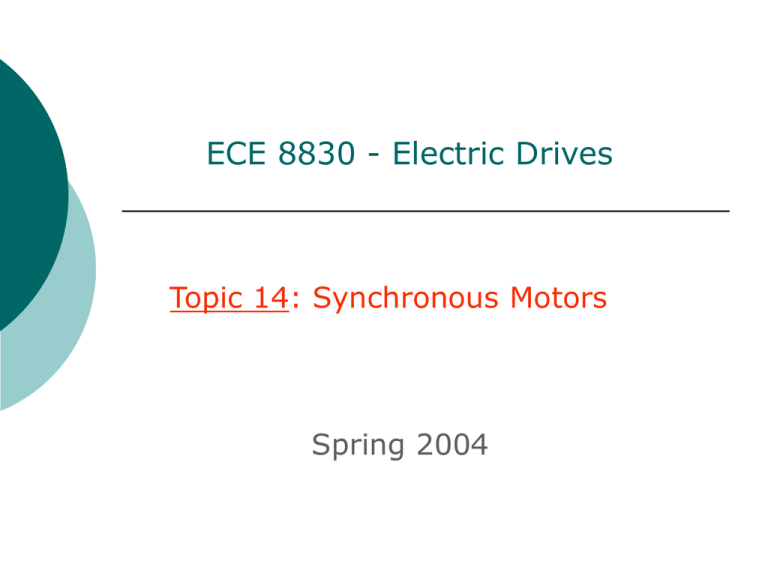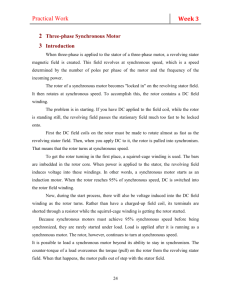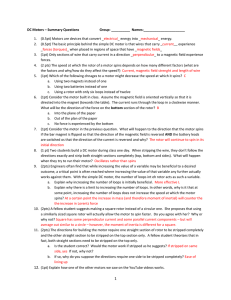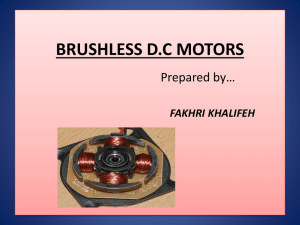Microelectromechanical Devices
advertisement

ECE 8830 - Electric Drives Topic 14: Synchronous Motors Spring 2004 Introduction The stator of a synchronous motor is identical to that of an induction motor. However, unlike an induction motor, a magnetic field is created by the rotor either through the use of permanent magnets or through a rotor winding with slip rings and brushes. The presence of the magnetic field on the rotor allows the rotor to move at synchronous speed with the stator field. Introduction (cont’d) The rotor shape of a synchronous motor may be salient or non-salient, i.e. the airgap may be non-uniform or uniform, respectively. Introduction (cont’d) Synchronous motors are more expensive than induction motors but offer the advantage of higher efficiency, an important advantage at high power. Thus, synchronous motors are used for power generation and large motor drives. A comparison of a 6MW induction motor and a wound field synchronous motor is shown on the next slide. Introduction (cont’d) Introduction (cont’d) Salient pole synchronous generators are used in low speed applications, such as in hydroelectric power stations where they are used to match the low operating speed of the hydraulic turbines. Non-salient pole synchronous generators are used in high-speed applications such as steam-power stations to match the high-speed steam turbines. Introduction (cont’d) In addition to the field winding, the rotor of a wound field synchronous motor usually also contains a second winding. This armortisseur, or damper winding, is like the short-circuited squirrel cage bars in an induction motor. Also, additional damper windings in the rotor can be used to represent the damping effects of eddy currents in the solid iron of the rotor poles. Introduction (cont’d) The de-axis is aligned with the North pole of the rotor and the qe-axis is aligned orthogonally to the de-axis. Note: In Ong’s book the qe-axis leads the de-axis whereas in Bose’s book the qeaxis lags the de-axis. Equivalent Circuit of Non-Salient Pole Wound Rotor Motor A simple per-phase equivalent circuit for a round rotor synchronous motor can be developed in a manner similar to the perphase equivalent circuit of the induction motor. The figure on the next slide shows a transformer-coupled circuit linking the stator and the moving rotor winding. Equivalent Circuit of Non-Salient Pole Wound Rotor Motor (cont’d) The rotor is supplied with a current If produced by a voltage Vf. Equivalent Circuit of Non-Salient Pole Wound Rotor Motor (cont’d) The rotor circuit can be replaced by an ac current source whose amplitude is If’(=nIf ) and frequency is e. That results in the equivalent circuit below: Equivalent Circuit of Non-Salient Pole Wound Rotor Motor (cont’d) Neglecting Rm and replacing the current source and parallel inductance with a Thevenin equivalent, we get the equivalent circuit shown below: Mathematical Model of the Wound Rotor Motor (cont’d) The winding inductances for deriving a mathematical model of a synchronous machine are shown below: Mathematical Model of the Wound Rotor Motor (cont’d) Before writing down the equations for this particular circuit, let us examine the variation of inductances with rotor position. While the rotor mmf’s will be aligned along the d- and q-axes, this is not necessarily true of the stator mmf’s. We therefore resolve the stator mmf’s in these two directions. Mathematical Model of the Wound Rotor Motor (cont’d) The resolved components of the a-phase mmf, Fa, results in flux components along the d- and q-axes given by: d Pd Fa sin r q Pq Fa cos r where Pd and Pq are the permeances along the d- and q-axes. Mathematical Model of the Wound Rotor Motor (cont’d) The flux linkage of these flux components with the a-phase winding is: aa N s (d sin r q cos r ) Ns Fa ( Pd sin 2 r Pq cos2 r ) A B cos 2 r where A Pd Pq 2 and B Pd Pq 2 Mathematical Model of the Wound Rotor Motor (cont’d) Similarly, the linkage of the flux components by the b-phase windings that is 2/3 are given by: 2 2 ba N s Fa Pd sin r sin r Pq cos r cos r 3 3 A B cos 2 r 3 2 Mathematical Model of the Wound Rotor Motor (cont’d) Based on these relationships, we can write expressions for the self-inductance for the a-phase (excluding leakage inductance): Laa L0 Lms cos 2 r Similar expressions can be written for the self-inductances for the b- and c-phases except that r is replaced by (r-2/3) and (r-4/3), respectively. Mathematical Model of the Wound Rotor Motor (cont’d) Similarly, the mutual inductances between the a- and b- phases are given by: L0 Lab Lba Lms cos 2 r 2 3 Similarly, Lbc and Lca expressions are obtained by replacing r by (r-2/3) and (r-4/3), respectively. Mathematical Model of the Wound Rotor Motor (cont’d) The voltage equations for the seven stator and rotor windings can now be written as: v s rs v 0 r 0 i s d s rr i r dt r where: vs=[va vb vc]T, vr=[vf vkd vg vkq]T, is=[ia ib ic]T, ir=[if ikd ig ikq]T, rs=diag[ra rb rc], rr=diag[rf rkd rg rkq], s=[a b c]T, and r=[f kd g kq]T. Mathematical Model of the Wound Rotor Motor (cont’d) We can now write down the equations for the flux linkages of the stator and rotor windings as: s Lss i s Lsr i r r L sr i s L r i r T where Lss= 1 1 L L L cos 2 L L cos 2 L L cos 2 ls 0 ms r 0 ms r 0 ms r 2 3 2 3 1 1 L L cos 2 L L L cos 2 L L cos 2 0 ms ls 0 ms r 0 ms r r 2 3 2 1 1 L L cos 2 L L cos 2 L L L cos 2 r 0 ms 0 ms ls 0 ms r r 3 2 2 Mathematical Model of the Wound Rotor Motor (cont’d) Llf Lmf Lrr= Lkdf 0 0 Lsr= Lsf sin r 2 L sin sf r 3 2 Lsf sin r 3 L fkd 0 Llkd Lmkd 0 0 0 Llg Lmg Lkqg Lskd sin r 2 L sin skd r 3 2 L sin skd r 3 0 Lgkq Llkq Lmkq 0 Lsg cos r 2 L cos sg r 3 2 L cos sg r 3 Lskg cos r 2 L cos skq r 3 2 L cos skq r 3 Mathematical Model of the Wound Rotor Motor (cont’d) We notice from these equations that the elements of Lss and Lsr are functions of the rotor angle r which is varying with rotation of the rotor. This is the same problem that we encountered with the induction motor and the solution was to transform to the rotor reference frame. We do the same thing here - Park’s transformation to the rescue once more! Mathematical Model of the Wound Rotor Motor (cont’d) Recall the Park’s transform matrix is: cos r 2 Tqd 0 ( r ) sin r 3 1 2 2 2 cos r cos r 3 3 2 2 sin r sin r 3 3 1 1 2 2 and the inverse transform matrix is: cos r 1 2 Tqd 0 ( r ) cos r 3 2 cos r 3 sin r 2 sin r 3 2 sin r 3 1 1 1 Mathematical Model of the Wound Rotor Motor (cont’d) Applying the Park’s transform to the stator voltage equations, we get: 1 qd 0 qd 0 v qd 0 Tqd 0rs T i Tqd 0 d 1 Tqd 0 qd 0 dt If ra=rb=rc=rs, the first term simplifies to: Tqd 0rs Tqd10i qd 0 rs i qd 0 Mathematical Model of the Wound Rotor Motor (cont’d) Now, Tqd 0 d 1 d 1 1 d Tqd 0 qd 0 Tqd 0 Tqd 0 qd 0 Tqd 0 qd 0 dt dt dt It can be shown that, d 1 Tqd 0 qd 0 dt sin r 2 r sin r 3 2 sin r 3 d r where r . dt cos r 2 cos r 3 2 cos r 3 0 0 qd 0 0 Mathematical Model of the Wound Rotor Motor (cont’d) and that d 1 Tqd 0 Tqd 0 qd 0 dt Since, 1 qd 0 Tqd 0 T 0 1 1 r 1 0 0 qd 0 0 0 0 d d qd 0 qd 0 dt dt the stator voltage equations in the rotor qd reference frame become simply: v qd 0 0 1 0 d rs i qd 0 r 1 0 0 qd 0 qd 0 dt 0 0 0 Mathematical Model of the Wound Rotor Motor (cont’d) The flux linkages can be obtained in a similar manner by only transforming the stator quantities : qd 0 Tqd 0Lss Tqd10i qd 0 Tqd 0Lsr i r The resulting equations are: 3 q Lls ( L0 Lms ) iq Lsg ig Lskq ikq 2 3 d Lls ( L0 Lms ) id Lsfd i f Lskd ikd 2 0 Lls i0 Mathematical Model of the Wound Rotor Motor (cont’d) The rotor winding flux linkages do not need to be transformed. The expressions for the rotor flux linkages are: 3 f Lsf id L ff i f L fkd ikd 2 3 kd Lskd id L fkd i f Lkdkdkd ikd 2 3 g Lsg iq Lgg ig Lgkq ikq 2 3 kq Lskq iq Lgkq ig Lkqkq ikq 2 Mathematical Model of the Wound Rotor Motor (cont’d) The 3/2 terms in the above rotor equations will result in non-symmetric inductance coefficient matrices. Therefore we multiply the actual rotor current terms by 2/3 to produce equivalent rotor currents which result in symmetric inductance coefficient matrices, i.e. 2 2 i f i f ; i kd ikd ; 3 3 2 i g ig 3 2 ; i kq ikq 3 Mathematical Model of the Wound Rotor Motor (cont’d) The rotor quantities can be referred to the stator as described in the Ong text pp. 267-269. The resulting equations in the rotor’s qd0 reference frame (with rotor quantities referred to the stator) can be summarized as shown on the next slide. Mathematical Model of the Wound Rotor Motor (cont’d) Mathematical Model of the Wound Rotor Motor (cont’d) The qd0 equivalent circuits from these equations are shown below: Mathematical Model of the Wound Rotor Motor (cont’d) The power into the machine is given by: Pin va ia vbib vcic v f i f vg ig Using the transformations of the stator quantities to the rotor qd0 reference frame, this equation becomes: 3 Pin vq iq vd id 3v0i0 v f i f vg ig 2 Mathematical Model of the Wound Rotor Motor (cont’d) With further algebraic manipulation and removing the ohmic loss and rate of change of magnetic energy terms, the electromechanical power developed by the motor can be expressed as: 3 Pem r (d iq q id ) 2 For a P-pole motor with rotor speed rm mechanical radians/sec. we can write: 3P Pem rm (d iq q id ) 22 Mathematical Model of the Wound Rotor Motor (cont’d) Thus the electromechanical torque provided by the motor is given by: Tem Pem rm 3P (d iq q id ) 22 Steady State Operation Assuming balanced, steady state conditions with the rotor rotating at synchronous speed, e, and the field excitation held constant, we can write the stator phase voltages as: va Vm cos et 2 vb Vm cos et 3 4 vc Vm cos et 3 Steady State Operation (cont’d) The steady state stator currents flowing into the motor are given by: ia I m cos et 2 ib I m cos et 3 4 ic I m cos et 3 Steady State Operation (cont’d) At this stage, we do not know the relative orientation of the rotor’s qr axis and the synchronously rotating qe axis but since the qr axis rotates at synchronous speed, the relative orientation will be constant in time. Let us define an angle (known as the power or torque angle) which represents the phase difference between VA and Ef (=r(t)- e(t)). Steady State Operation (cont’d) In steady state, the qd voltage equations of the stator windings in the rotor qd reference frame may be written as: vq rs iq e Ld id E f vd rs id e Lq iq where Ef is the steady state field excitation voltage on the stator side given by: Ef v 'f e Lmd ' r f Steady State Operation (cont’d) These equations can be used to derive an expression for (see Ong pp. 274-276). The resulting expression is: tan rs I m sin e Lq I m cos Vm rs I m cos e Lq I m sin For a non-salient pole motor, the torque can be shown to be given by (see Bose pp. 7980): P Te 3 s I s cos 2 Steady State Operation (cont’d) For a salient pole motor, the torque can be shown to be given by (see Bose pg. 81): L L ds qs P s f Te 3 sin s2 sin 2 2 Lds Lqs 2 Lds The torque- curves for the two types of motor are shown below: Phasor Diagrams The phasor diagrams for motoring mode are shown below. See Ong pg. 278 for details. Leading PF Lagging PF Simulation Model of Three-Phase Synchronous Motor The winding equations derived earlier can be used for a simulation model. The model inputs include: 1) the stator abc phase voltages, 2) the excitation to the rotor field windings, and 3) the applied mechanical torque to the rotor. Simulation Model of Three-Phase Synchronous Motor (cont’d) The simulation model outputs are: 1) the three stator abc phase currents, 2) the field current in the rotor, 3) the electromagnetic torque generated by the motor, 4) the speed of the rotor, and 5) the torque angle of the motor. Simulation Model of Three-Phase Synchronous Motor (cont’d) The first step in developing the simulation model is to transform the abc phase voltages to the qd reference frame attached to the rotor. This can be performed in two steps by first transforming to the stationary reference frame and then to the rotating reference frame of the rotor. Simulation Model of Three-Phase Synchronous Motor (cont’d) The transformation from the abc phase voltages to the stationary reference frame is given by: 2 1 1 v va vb vc 3 3 3 1 s vd (vc vb ) 3 s q 1 v0 (va vb vc ) 3 Simulation Model of Three-Phase Synchronous Motor (cont’d) The transformation from the stationary reference frame to the rotor reference frame is given by: vq v cos r (t ) v sin r (t ) s q s d vd v sin r (t ) v cos r (t ) s q s d t where r (t ) r (t )dt r (0) 0 Simulation Model of Three-Phase Synchronous Motor (cont’d) For the case of a wound rotor synchronous motor with one field winding in the d-axis and a pair of damper windings in the dand q-axes, we can write integral equations for the winding flux linkages as: r q b vq r d s ( mq q ) dt b xls kq' rs r d b vd q ( md d ) dt b xls rs 0 b v0 0 dt xls kd' ' f b rkq' ' xlkq b rkd' ' xlkd b rf' xmd ' mq kq dt kd' dt md xmd ' E f xlf' md f dt Simulation Model of Three-Phase Synchronous Motor (cont’d) In the previous expressions, mq b Lmq (iq ikq' ) 'f xlf' i 'f md md b Lmd (id i i ) ' kd E f xmd v'f ' f r q xls iq mq ' f ' kd x i md ' ' lkd kd x i mq ' kq d xlsid md ' ' lkq kq 0 xlsi0 Note: All of the above equations assume a motoring current convention. Simulation Model of Three-Phase Synchronous Motor (cont’d) From the flux linkages, we can get the dand q-axis stator, and d- and q-axis and field rotor (referred back to the stator) winding currents as follows: ' q mq kq mq ' ikq iq ' xlkq xls id d md xls ikd' i 'f kd' md ' xlkd 'f md xlf' Simulation Model of Three-Phase Synchronous Motor (cont’d) We can now get the abc phase winding currents by a two-step transformation. First we transform from the rotor qd0 reference frame to the stationary qd0 reference frame. This is accomplished through the below transformation: iqs iq cos r (t ) id sin r (t ) i iq sin r (t ) id cos r (t ) s d Simulation Model of Three-Phase Synchronous Motor (cont’d) The second step is to transform from the stationary qd0 reference frame back to abc using the following transformation: ia iqs i0 1 s 1 s ib iq id i0 2 3 1 s 1 s ic iq id i0 2 3 Simulation Model of Three-Phase Synchronous Motor (cont’d) For a motor, net acceleration torque =Tem+Tmech-Tdamp From Newton’s 2nd law of motion applied to a rotating body, we have: Tem Tmech Tdamp P r (t ) e 2J d rm (t ) 2 J d r (t ) J dt P dt t T em 0 Tmech Tdamp dt Simulation Model of Three-Phase Synchronous Motor (cont’d) In this equation, the electromagnetic torque produced by the motor can be calculated as shown earlier by: Tem Pem rm 3P (d iq q id ) 22 Also, the torque angle can be calculated in simulation from the equation: (t ) r (t ) e (t ) r (t ) e dt r (0) e (0) t 0 Simulation Model of Three-Phase Synchronous Motor (cont’d) The flow of variables for simulation of the synchronous motor is shown for the q-axis circuit here and for the d-axis circuit on the next slide. Simulation Model of Three-Phase Synchronous Motor (cont’d) Per-Unit Expressions for Synchronous Motor Normalization of machine parameters allows for standardized comparison of different machines. The per-unit (p.u.) expressions for synchronous motors are as follows: Base Power, Sb, is rated kVA of machine Base Voltage, Vb, is peak voltage, 2Vlineto line i.e. Vb 3 Base Current, Ib, is peak current =2Sb/3Vb Base Impedance, Zb=Vb/Ib Base Torque, Tb = SbP/2b ,where b is base electrical angular frequency. Synchronous Motor Parameters Synchronous motor parameters from manufacturers are usually in the form of reactances, time constants, and resistances which are derived from stator measurements. Two time constants appear in the transient behavior of the rotor - a subtransient period (during the first few cycles of a short circuit of the windings) when the current decay is very rapid. This is followed by the transient period in which the current decay is slower. These two time constants are denoted as Tdo’ and Td0”. Synchronous Motor Parameters (cont’d) The reactances, resistances and time constants can be used to calculate the synchronous motor parameters as described on pp. 302-304 Ong. A sample calculation of synchronous motor parameters is also provided in this section. Higher-Order Models Significant error is found in some cases between simulations using the model described earlier and actual synchronous motor performance, especially in the rotor winding components of motors with solid iron rotors. The main source of error is the shielding effects of the damper winding currents and the eddy currents in a solid rotor. Higher-Order Models (cont’d) A third circuit to account for the eddy currents induced in the pole surface can be incorporated into the model. The three current components in the rotor slot are shown below: Higher-Order Models (cont’d) The field current path is deep in the slot and links the slot leakage flux components shown. The damper current path is higher up in the slot and links r1c partially and all of r2c directly above it. The eddy currents flow in the surface of the slot and partially links r2c but not r1c. Higher-Order Models (cont’d) The qd0 circuits need to be modified from the earlier circuits to incorporate additional inductances Lr1c and Lr2c to account for the fluxes r1c and r2c in the rotor slot and L’1c, L’2c, and L’3c to account for the self-leakages of the field, damper and eddy currents. The modified qd0 circuits are shown on the next slide. Higher-Order Models (cont’d) Higher-Order Models (cont’d) The simulation equations for the higher order model represented by these modified circuits are developed in sec. 7.8.1 (pp. 307-309) in Ong’s book.









